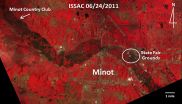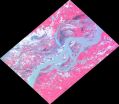HOUSTON, TX, November 20, 2012 (Press-News.org) They say a picture is worth a thousand words, but in the case of cameras aboard the International Space Station, a picture may impact a thousand lives or more. The International Space Station Agricultural Camera, or ISSAC, provides images capable of important impacts for Earth users. Originally meant as an agricultural resource, ISSAC completed its primary science operations in September, but now answers the call for disaster response on a global level.
ISSAC launched to the space station in January 2011. Since June 2011, it has operated as a tool for improved geographic stewardship. Beginning in the spring of 2012, the camera joined disaster relief resources as one of multiple space station assets available to provide images at the request of the International Disaster Charter, or IDC.
Participants in this charter collect images on a "best-effort" basis of areas impacted by natural disasters. Orbital remote sensing systems, maintained by several participating space agencies, capture the images and the data are made available to appropriate organizations in the impacted regions. Responders on the ground can use this data to generate resources, such as near real-time fire and flood maps.
The primary purpose of ISSAC was to help farmers and ranchers in the upper U.S. Midwest improve their agricultural production, while minimizing impact on the environment. ISSAC uses a multi-spectral camera that resides in the space station's Window Observational Research Facility, or WORF.
The camera's ability to identify healthy plant life has to do with the equipment's multispectral sensors, which use both visible and infrared light to capture Earth images. ISSAC has a single 150 mm lens and optical beam splitter that separates the light into red, green, and near infrared light band passes, each going to one of three separate internal digital cameras. Of these, the red and near infrared bands are particularly useful when studying vegetation.
Plant life is highly absorptive of the red band and reflective in the near-infrared band. When researchers on the ground combine this data into a Normalized Difference Vegetation Index, the results indicate any reductions in plant health. A decrease in the near-infrared band can indicate heat or drought stress on crops, while an increase in red band reflectance points to reduced chlorophyll production. Once taken, ISSAC images were downlinked to the ground where they were processed for delivery to end users in a matter of days.
Farmers can use ISSAC data from the previous growing season to help make more effective use of fertilizers and other chemicals, reducing environmental impacts. Ranchers can request similar data to avoid ecosystem damage from erosion and livestock overgrazing of rangelands. In addition, researchers may use ISSAC to see if frequent multi-spectral imagery could help map nitrogen content in plant biomass, among other research application investigations.
ISSAC had planned to offer frequent data collection and improved image resolution for specific geographic area requests. This capacity for rapid data production, with multi-week to multi-day imaging, would be a supplement to other sun-synchronous orbiting cameras, such as Landsat. In November 2011, however, the pointing system for ISSAC stopped working. Although this significantly reduced the rapid-response capability, the camera could still take images in a nadir-pointing mode, or straight down towards Earth while over a given location.
ISSAC's vantage point on the space station also makes it ideal to help monitor natural disasters, providing a valuable secondary resource application. An example of this can be seen in the image taken of Minot, N.D., when the area suffered record flooding in the summer of 2011. In the ISSAC image of the Minot flooding, the three color bands--green, red, and near-infrared--are assigned respectively to blue, green, and red colors. Vegetation appears red, with brighter shades indicating more plant life.
"Standing water looks black, since it reflects almost nothing in the near-infrared, and the Souris River Valley is visible as a dark strip in the image. As you can see, during this flood the river is more than a mile wide; when it is not flooding, it is just a few yards wide," said Olsen.
Since the space station resources were added to the IDC, there have been 25 activations. To date ISSAC was able to respond to seven of these: fires in northern Algeria, an earthquake in Iran, flooding in Pakistan, flooding in Nigeria, flooding in Cameroon, and damage from Hurricane Sandy in Haiti, as well as data collection along the upper U.S. eastern coastline following the storm.
"The ISSAC images are being added to the main data directory of the USGS [U.S. Geological Survey] Hazards Data Distribution System (HDDS), which will make them directly available to end-users in countries that have requested data through the IDC," said Will Stefanov, senior remote sensing specialist with NASA's International Space Station Program Science Office.
A student-based staff at the University of North Dakota ISSAC Science Operations Center controlled the camera remotely during primary science operations. This provided an educational component to the instrument development process. Student operators worked in coordination with NASA's International Space Station Payloads Operations and Integration Facility, located at Marshall Space Flight Center.
"We have wildly exceeded our expectations from an academic outcome perspective," said Olsen. "More than 70 students have now worked on ISSAC in some way or another, including completion of 15 graduate-level theses/independent study projects."
ISSAC is planned to continue to operate through January 2013 when a new imaging device, the ISS SERVIR Environmental Research and Visualization System, or ISERV, will swap places with the camera at the station's WORF.
"Operations will be limited to assisting with monitoring of any natural disasters that may occur during that time," said Olsen "ISSAC has already been serving in this capacity as a secondary science objective since last January. Along with other end-of-mission activities, ISSAC will continue to perform such operations as needed for this secondary science mission."
For the latest news about research being done on the International Space Station, please visit:
http://www.nasa.gov/mission_pages/station/research/news.html
For more information on past, ongoing, and future ISS research activities, including research results and publications, please visit:
http://www.nasa.gov/mission_pages/station/research/index.html
If you are interested in subscribing to updates from the ISS Program Science Office, please visit:
https://lists.nasa.gov/mailman/listinfo/iss-program-science-group
For more information about the International Space Station, visit:
http://www.nasa.gov/station
For information about NASA and agency programs, visit:
http://www.nasa.gov
Space Station's ISSAC Continues to Keep a Helpful Eye on Earth
RELEASE: JR12-022
2012-11-20
ELSE PRESS RELEASES FROM THIS DATE:
Black Friday E Cigarette Sales List Announced By Smokers Utopia
2012-11-20
Smokers Utopia has added a special page for the upcoming holiday season that list the best deals for the electronic cigarette from the top companies in the industry.
Most retailers will be holding sales for the most popular shopping day of the year and e cigarette retailers are not different. This sends a frenzy of searches across the web hunting the best deals online on the popular shopping day.
Smokers Utopia has come up with a brilliant method to save shoppers looking for an e cigarette kit both time and money by doing the work for them.
"We thought it ...
Cruise.com's Annual Black Friday Sale Delivers Unprecedented Value
2012-11-20
Cruise.com, a subsidiary of Omega World Travel, Inc. and one of the Internet's leading cruise sellers, announces its annual Black Friday sale, delivering the industry's best values on cruise vacations, which will run from 8am on Friday, November 23 through Monday, November 26, 2012.
The online retailer's annual sales event will build on the successes of previous years, including reduced rates, up to $1,000 onboard credits, complimentary upgrades, complimentary spa treatments, free gratuities and special "2 for 1" rates. Plus guests can enjoy 50% reduced deposits ...
We're in this together: A pathbreaking investigation into the evolution of cooperative behavior
2012-11-19
Humans are much more inclined to cooperate than are their closest evolutionary relatives. The prevailing wisdom about why this is true has long been focused on the idea of altruism: we go out of our way to do nice things for other people, sometimes even sacrificing personal success for the good of others. Modern theories of cooperative behavior suggest that acting selflessly in the moment provides a selective advantage to the altruist in the form of some kind of return benefit.
A new study published by Current Anthropology offers another explanation for our unusual aptitude ...
JCI early table of contents for Nov. 19, 2012
2012-11-19
A code of silence in acute myeloid leukemia
The development of acute myeloid leukemia (AML) is associated with a variety of genetic changes. Some of these alterations are epigenetic, wherein the sequence of the genes is unchanged, but chemical modifications to the DNA alters gene expression. In a study published in the Journal of Clinical Investigation, researchers led by Daniel Tenen at Beth Israel Deaconess Medical Center found that a transcriptional regulator known as C/EBPG was highly expressed in a subset of AML samples that had an epigenetically silenced C/EBPA ...
Immune cell migration is impeded in Huntington's disease
2012-11-19
Huntington disease (HD) is an incurable neurodegenerative disease caused by a mutation in the huntingtin gene (htt). Though most of the symptoms of HD are neurological, the mutant HTT protein is expressed in non-neural cells as well. In this issue of the Journal of Clinical Investigation, researchers led by Paul Muchowski at the J. David Gladstone Institutes in San Franscisco examined the role of immune cells in HD. Immune cells known as microglia, which were isolated from the brains of HD mice, as well as immune cells from the peripheral blood were found to be defective ...
A code of silence in acute myeloid leukemia
2012-11-19
The development of acute myeloid leukemia (AML) is associated with a variety of genetic changes. Some of these alterations are epigenetic, wherein the sequence of the genes is unchanged, but chemical modifications to the DNA alter gene expression. In a study published in the Journal of Clinical Investigation, researchers led by Daniel Tenen at Beth Israel Deaconess Medical Center found that a transcriptional regulator known as C/EBPG was highly expressed in a subset of AML samples that had an epigenetically silenced C/EBPA gene. By blocking the epigenetic modification of ...
New species literally spend decades on the shelf
2012-11-19
Many of the world's most unfamiliar species are just sitting around on museum shelves collecting dust. That's according to a report in the November 20th issue of the Cell Press journal Current Biology showing that it takes more than 20 years on average before a species, newly collected, will be described.
It's a measure the researchers refer to as the species' "shelf life," and that long shelf life means that any conservation attempts for unknown, threatened species could come much too late. The problem, the researchers say, is due to a lack of experts and of the funding ...
No elevated 10-year risk of heart disease for people who become ill during a large E. coli outbreak
2012-11-19
According to a new study in CMAJ (Canadian Medical Association Journal), people who became ill during the Walkerton, Ontario, Escherichia coli O157:H7outbreak were not at greater risk of heart disease or stroke 10 years later.
E. coli O157:H7 is a common cause of 'food poisoning." This bacterium most recently caused the outbreak involving beef from XL foods (Alberta) in September 2012, and was the major cause of illness during the large Walkerton E. coli outbreak in May 2000. In the United States, there are 63 000 infections each year, with 12 major outbreaks since 2006. ...
Toward competitive generic drug prices in Canada
2012-11-19
The commitment of Canadian premiers to lower generic drug prices is a major change in how the country prices generic drugs, and government should learn from past attempts, states an article published in CMAJ (Canadian Medical Association Journal).
Generic drug prices are higher in Canada than in other industrialized countries. The authors argue that the premiers' call for a national bulk purchasing program, made earlier in 2012, is a positive step for Canadians.
"The joint commitment from Canada's premiers to use coordinated bulk purchasing to lower these prices is ...
Major advance in using sunlight to produce steam without boiling water
2012-11-19
WASHINGTON, Nov. 19, 2012 — Scientists today are describing a revolutionary new way to use sunlight to produce steam and other vapors without heating an entire container of fluid to the boiling point. The advance, reported in the American Chemical Society (ACS) journal ACS Nano, has potential applications, especially in the poverty-stricken areas of the developing world, that include inexpensive, compact devices for purification of drinking water, sterilization of medical instruments and sanitizing sewage.
"This research opens up a revolutionary new application of nanoparticles ...
LAST 30 PRESS RELEASES:
Electrodes created using light
Second-hand gift-giving is a well-deliberated decision
How human interaction drove evolution to make bears less aggressive
National Poll: Few parents offer teens guidance on healthy eating during holiday season
Cannabis derivatives could provide new ovarian cancer treatments
Raising strong yeast as a petroleum substitute
Clues to the origin of hot Jupiters hidden in their orbits
Canada’s reduced pledge to Global Fund will impact domestic health
1 in 4 children with major traumatic injuries not cared for in pediatric trauma centres
Duke and Duke-NUS’ joint cross-population research to uncover "East-West" differences in disease and care
Scientists to ‘spy’ on cancer- immune cell interactions using quantum technology breakthrough
Tech savvy users have most digital concerns
Making lighter work of calculating fluid and heat flow
Normalizing blood sugar can halve heart attack risk
Lowering blood sugar cuts heart attack risk in people with prediabetes
Study links genetic variants to risk of blinding eye disease in premature infants
Non-opioid ‘pain sponge’ therapy halts cartilage degeneration and relieves chronic pain
AI can pick up cultural values by mimicking how kids learn
China’s ecological redlines offer fast track to 30 x 30 global conservation goal
Invisible indoor threats: emerging household contaminants and their growing risks to human health
Adding antibody treatment to chemo boosts outcomes for children with rare cancer
Germline pathogenic variants among women without a history of breast cancer
Tanning beds triple melanoma risk, potentially causing broad DNA damage
Unique bond identified as key to viral infection speed
Indoor tanning makes youthful skin much older on a genetic level
Mouse model sheds new light on the causes and potential solutions to human GI problems linked to muscular dystrophy
The Journal of Nuclear Medicine ahead-of-print tip sheet: December 12, 2025
Smarter tools for peering into the microscopic world
Applications open for funding to conduct research in the Kinsey Institute archives
Global measure underestimates the severity of food insecurity
[Press-News.org] Space Station's ISSAC Continues to Keep a Helpful Eye on EarthRELEASE: JR12-022


